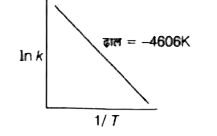The rate constant of a reaction is given by k=2.1×1010C−27002.303R
It means that
log k vs 1T will be straight line with slope =−27002.303R
log k vs 1T will be straight line with intercept on log k axis =log2.1×1010
the number of effective collisions are 2.1×1010cm−3sec−1
half-life of the reaction increases with increase in temperature
The correct Answer is:A, B
(A) and (B) are correct, (C ) is wrong because frequency factor gives total number of collisions and not the effective collision cm−3sec−1, (D) is wrong because half-life of the reaction decreases with increase in temperature (as reaction becomes faster)
Topper's Solved these Questions
- CHEMICAL KINETICS AND RADIOACTIVITYBook:FIITJEEChapter:CHEMICAL KINETICS AND RADIOACTIVITYExercise:Comprehension I
Explore 3 Videos
- CHEMICAL KINETICS AND RADIOACTIVITYBook:FIITJEEChapter:CHEMICAL KINETICS AND RADIOACTIVITYExercise:Comprehension II
Explore 2 Videos
- CHEMICAL KINETICS AND RADIOACTIVITYBook:FIITJEEChapter:CHEMICAL KINETICS AND RADIOACTIVITYExercise:Solved problem (subjective)
Explore 15 Videos
- CHEMICAL EQUILIBRIUMBook:FIITJEEChapter:CHEMICAL EQUILIBRIUMExercise:MATCHING TYPE QUESTIONS
Explore 3 Videos
- CHEMISTRY IN EVERY DAY LIFE Book:FIITJEEChapter:CHEMISTRY IN EVERY DAY LIFE Exercise:ASSIGNMENT PROBLEMS (OBJECTIVE) Level - II (Numerical Based Questions)
Explore 5 Videos
Similar Questions
Unstable nuclei attain stability through disintergration. The nuclear stability is related to neutron- proton ratio (n/p).n/p ratio for stable nuclei lies quite close to unity for elements with low atomic numbers (20 or less) but it is more than one for nuclei having higher atomic numbers. Nuclei having n/p ratio either very high or low undergo nuclear transformation.
(i) When n/p ratio is higher than required for stability, the nuclei have the tendency to emit β-rays, i.e. a neutron is converted into a proton.
(ii) When n/p ratio is lower than required for stability, the nuclei increase the ratio, either by emitting α-particle or by emitting a positron or by K-electron capture.
2713Al is a stable isotope , 2913Al is expected to disintegrate by-
View SolutionCarbon -14 is used to determine the age of organic material. The procedure, is based on the formation of .14C by neutron capture in the upper atmosphere.
147N+0n1→146C+1n1.
14C is absorbed by living organisms during photosynthesis. The .14C content is constant in living organism once the plant or animal dies, the uptake of carbon dioxide by it ceases and the level of 14C in the dead being, falls due to the decay.which C14 undergoes
146C→147N+β−
The half life period of 14C is 5770 years. The decay constant (λ) can be calculated by using the following formula λ=0.693t1/2
The comparison of the β− activity of the dead matter with that of the carbon still in circulation enables measurement of the period of the isolation of the material from the living cycle. The method however, ceases to be accurate over periods longer than 30,000 years. The proportion of 14C to 12C in living matter is 1:1012.
Which of the following option is correct ?
View SolutionThe energy of activation for a reaction is 100kJ/mol. Presence of catalyst lowers the energy of activation by 75%. What will be effect on rate of reaction at 20∘C, other things being equal ?
View Solution

Which of the following combination is correct ?
View SolutionHow many of the following are water soluble vitamins ?
A, B, C, D , K, E
View SolutionThe rate constant of a reaction is given by k = 2.1 xx 10^(10) exp(-2700//RT) . It means that
View SolutionA reaction rate constant is given by
k=1.2×1014e−2500RTs−1. It means
View SolutionCalculate the rate of reaction for the change, 2Ararr Products, when rate constant of the reaction is 2.1xx10^(-5) time^(-1) and [A]_(0)=0.2M .
View SolutionThe equilibrium constant K_(c) is 10^(2) for the reaction AB + C hArr AC + B The rate constant for the forward reaction K is 10^(6) , the rate constant of backward reaction is
View SolutionA reaction rate constant is given by k = 1.2 xx 10^(14) e^(-(25000//RT)) sec^(-1) . It means
View SolutionThe rate constant of a reaction is given as k=2.1xx10^(10)e^(-2700//RT) It means that "log "k " vs "1//T will be a straight line with intercept on "log "k" axis"=log2.1xx10^(10). Number of effective collisions of temperature are 2.1xx10^(10)cm^(-3)s^(-1). Half-life of a reaction increases of temperature. "log"k" vs "1//T will be a straight line with slope=-(2700)/(2.303R). Which of the above statements are true? Choose the correct option.
View SolutionThe rate constant of a reaction is given by k=2.1xx10^(10)" exp "(-2700/RT) It means that
View SolutionThe equilibrium constant K of a reversible reaction is 10. The rate constant for the reverse reaction is 2.8. What is the rate constant for the forward reaction
View Solutionएक अभिक्रिया के लिए दिए गए चित्र में ln k vs 1/T के प्लॉट पर विचार कीजिए। यदि इस अभिक्रिया का दर नियतांक 400 K पर। 10−5s−1 है, तो 500 K पर उसका दर नियतांक है|

View SolutionThe rate constant of a first order reaction is given by K=2.1×1010exp(−2700/T). It meas that
View Solution

